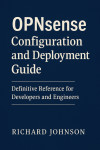OPNsense Configuration and Deployment Guide by Richard Johnson
Synopsis
"OPNsense Configuration and Deployment Guide"
The "OPNsense Configuration and Deployment Guide" is a comprehensive resource designed for IT professionals, network architects, and security administrators seeking in-depth mastery over OPNsense, the powerful open-source firewall and routing platform. The book begins by establishing a robust foundational knowledge, meticulously detailing OPNsense’s architectural landscape, core networking components, and security model. Readers are introduced to the principles underlying the development of OPNsense, including its modular design and rapid, community-driven upgrade cycles. Emphasis is placed on extensibility via plugins and the best practices that ensure a hardened, secure deployment.
Guided by practical, real-world scenarios, the guide transitions seamlessly into deployment strategies, covering installation nuances across physical, virtual, and cloud environments. Each chapter explores the entire life cycle: from hardware selection to advanced automated provisioning, initial configuration workflows, and troubleshooting challenging installations. The book further delivers expert insights into interface management, sophisticated VLAN and routing configurations, and the orchestration of resilient, high-availability networks. Step-by-step walkthroughs empower readers to build and segment networks, implement robust firewall policies, and integrate advanced threat prevention with IDS/IPS.
Beyond core networking, this guide delves into the essential services and security measures required for modern enterprise environments. Comprehensive sections cover VPN deployments—including OpenVPN, IPsec, and WireGuard—alongside best practices for certificate lifecycle management and multi-factor authentication. Detailed chapters on DNS, DHCP, proxy services, monitoring, automation, and SIEM integration ensure operational excellence. The book concludes with advanced topics in security hardening, compliance architecture for regulatory mandates, and incident response frameworks, making it an indispensable manual for both daily operations and long-term strategic planning in secure network infrastructure.
Reviews
Write your review
Wanna review this e-book? Please Sign in to start your review.












